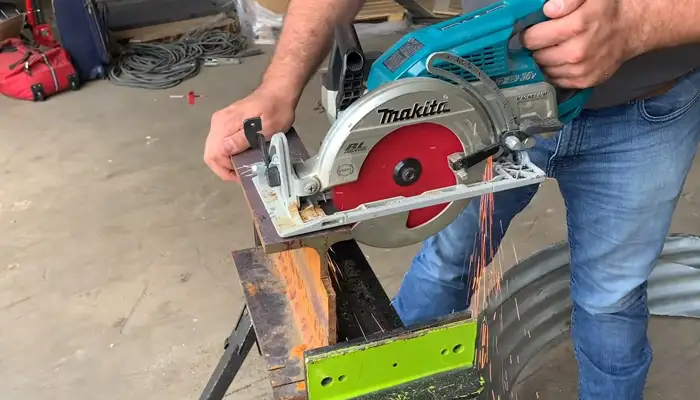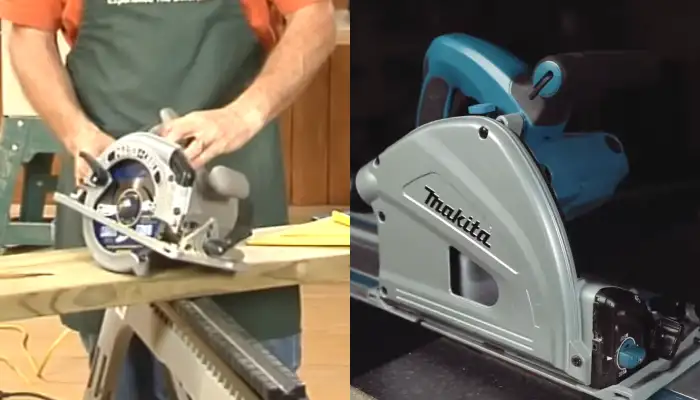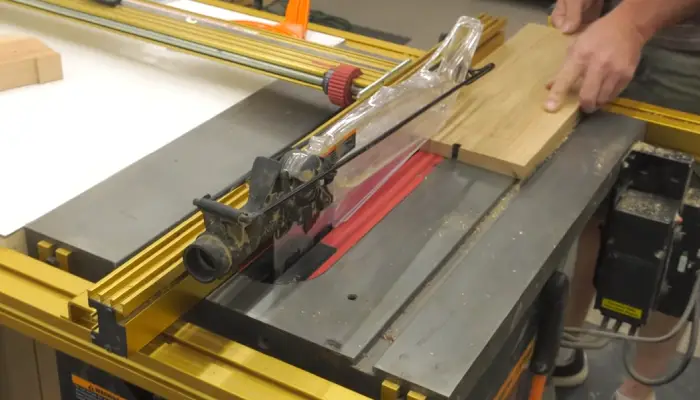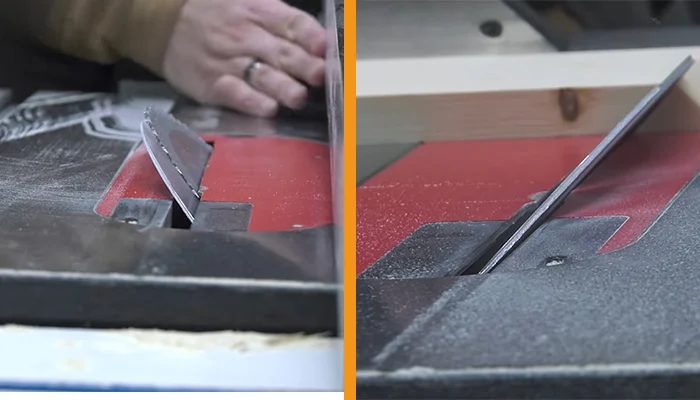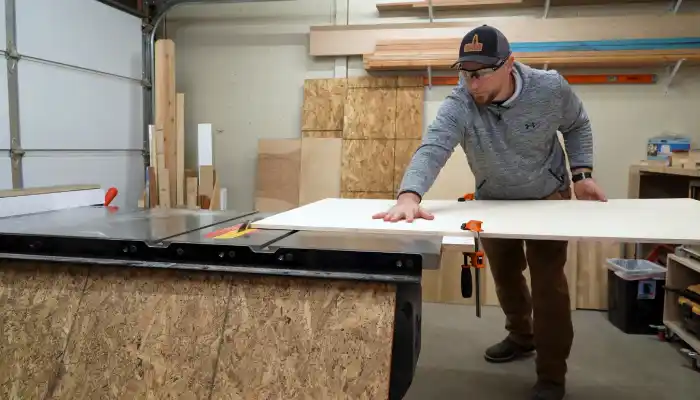Can Circular Saws Cut Metal: 5 Factors to Consider
Metal cutting with circular saws is a versatile and essential skill, offering efficiency and precision in various applications. The ability to transform raw metal into custom shapes and sizes is crucial across industries, from construction to metalworking.
I know what you’re thinking: Is it possible to cut through tough metal with a circular saw designed for cutting wood? Well, let me tell you, it’s not as impossible as it seems.
With the right blades and discs for metal cutting and a few adjustments, circular saws can tackle metal with precision and efficiency.
Here, I’ll walk you through the factors to consider and the techniques to use when cutting metal with a circular saw. Get ready to expand your saw’s capabilities.
Can Circular Saws Cut Metal: Factors to Consider
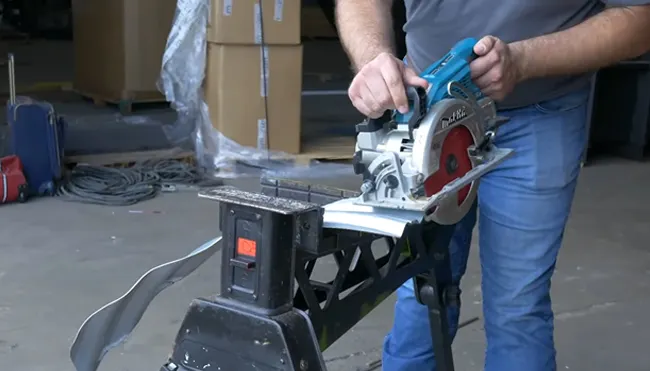
When cutting metal with circular saws, there are several factors that need to be considered. According to my research, these are the most important:
- Blade selection and alignment
- Cutting depth and workpiece preparation
- Linear speed and operational differences
- Blade lubrication and cooling
- Safety measures and precautions
No 01: Blade Selection and Alignment
To effectively cut metal with a circular saw, I strongly suggest you carefully select and align the appropriate blade. Metal-cutting blades differ significantly from those used for wood, as they’re specifically designed for metal applications.
When selecting a blade, it’s crucial to consider the type of metal being cut. Specialized blades are available for metals such as steel and nonferrous materials like aluminum.
Additionally, abrasive blades are suitable for cutting harder metals. The tooth count of the blade is also important, as it determines the cutting speed and the quality of the finished cut.
Once the appropriate blade is selected, it must be aligned properly to ensure optimal cutting performance and safety. Incorrect alignment can result in poor cuts, blade damage, and potential accidents.
Therefore, following the manufacturer’s guidelines for blade alignment is essential, and ensuring that the blade is securely tightened before starting the metal cutting process.
No 02: Cutting Depth and Workpiece Preparation
Controlling the cutting depth is crucial to ensure precise and efficient cuts. You need to adjust the tool so that it doesn’t exceed ¼ inch beyond the thickness of the cut metal. This prevents excessive material removal and minimizes the risk of damaging the workpiece or the saw blade.
Thorough preparation of the workpiece is essential for successful metal cutting. You can mark the cutting line accurately, ensuring it’s visible and aligned with the saw blade.
Secure the metal firmly in place using clamps to prevent movement during cutting. It’s also important to ensure adequate blade clearance to avoid any obstructions or interference while cutting.
No 03: Linear Speed and Operational Differences
Understanding the operational differences, particularly in linear speed, is crucial to effectively cutting metal with a circular saw, in my opinion.
Metal-cutting circular saws operate at lower linear speeds compared to wood-cutting saws. This deliberate reduction in speed, typically around 4,000 RPM, serves two important purposes.
Firstly, it minimizes heat generation during the cutting process. The slower speed allows for better heat dissipation, preventing the metal from overheating and potentially altering its properties.
Secondly, it helps to minimize sparks, which can be a safety hazard when cutting metal. By reducing the linear speed, the circular saw creates less friction between the metal and the blade, resulting in fewer sparks.
Therefore, when selecting a circular saw for cutting metal, the operational differences in linear speed must be considered to ensure efficient and safe cutting.
No 04: Blade Lubrication and Cooling
Blade lubrication and cooling ensure efficient and safe metal cutting with circular saws. When cutting metal, the blade generates significant heat due to the friction between the blade and the workpiece. This heat can lead to premature blade wear, reduced cutting performance, and even pose a safety hazard.
To counteract this, it’s essential to apply cutting fluid to the cutting area regularly. Cutting fluid reduces friction between the blade and the metal surface, allowing for a smoother cut. Additionally, cutting fluid helps dissipate heat effectively, preventing the blade from overheating.
No 05: Safety Measures and Precautions
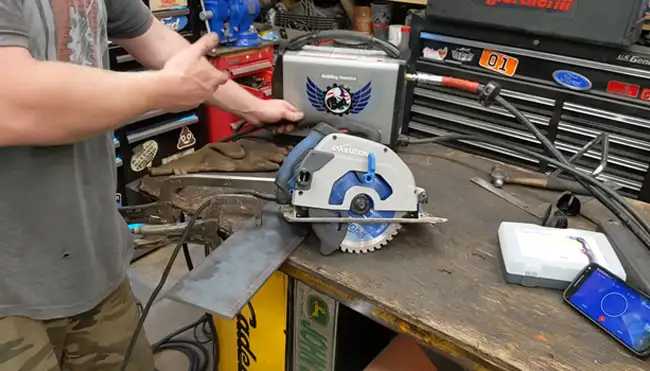
When cutting metal with circular saws, I always say to prioritize safety measures and take necessary precautions to ensure a secure working environment.
- Wear appropriate personal protective equipment, including safety glasses, gloves, and hearing protection.
- In order to prevent movement during cutting, clamp or vise the workpiece firmly.
- Maintaining a safe distance between your body and the saw blade is crucial, keeping your hands and fingers away from the cutting line.
- To further minimize the risk of accidents, ensure the saw is equipped with a blade guard and a properly functioning safety switch.
- Lastly, be mindful of the potential hazards of hot chips and sparks.
How Can You Cut Metal With Circular Saws?
According to my findings, several important points must be considered when cutting metal with circular saws.
Step 01: Blade Selection
Choosing the right metal-cutting blade is crucial for effectively using a circular saw to cut metal. These blades are specifically designed to withstand the rigors of metal cutting and have distinct characteristics that ensure optimal performance.
Firstly, they’re available in smaller sizes, allowing for precise and controlled cuts. Additionally, metal-cutting blades typically feature slower teeth rotation, which helps maintain stability and accuracy during cutting.
Moreover, these blades often have carbide or abrasive tips, enhancing their durability and enabling them to cut through various types of metals easily. When selecting a metal-cutting blade, it’s essential to consider the specific type of metal you intend to cut, as different blades are designed for different metals.
Step 02: Workpiece Preparation
Accurate marking is crucial to ensure precision during the cutting process. I recommend using a straight edge or a square to make a clear and visible cutting line on the metal surface. This helps to maintain a straight and even cut.
Once the cutting line is marked, proceed to secure the metal using clamps firmly. This prevents any movement or shifting of the workpiece during the cutting process, ensuring a clean and accurate cut.
When cutting metal with a circular saw, these steps must be taken to maintain safety and achieve the desired results.
Step 03: Adjust Cutting Depth
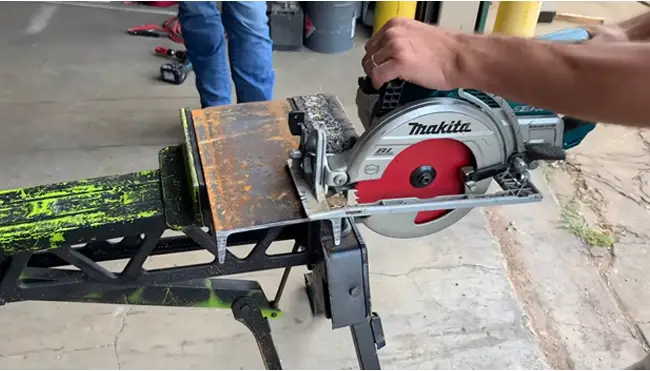
Exceeding the recommended cutting depth can lead to blade binding, increased vibration, and potentially dangerous kickback. It’s crucial not to exceed ¼ inch (6 mm) beyond the metal thickness.
You can utilize the circular saw’s blade-adjustment mechanism to achieve the desired cutting depth. This mechanism allows you to raise or lower the blade, ensuring it penetrates just enough to cut through the metal without exceeding the specified limit.
Step 04: Cutting Procedure
I recommend employing a systematic cutting procedure when working with metal with a circular saw to achieve precise and controlled cuts.
- Once the saw is aligned and powered up, it’s time to guide it steadily along the marked cutting line, ensuring a controlled pace for accuracy.
- Maintaining a firm grip on the saw is crucial. If necessary, use cutting guides to assist in maintaining a straight path.
- Throughout the cutting process, pay close attention to address any deviations or issues that may arise promptly.
- And prioritize safety by avoiding abrupt movements and maintaining a stable stance throughout the operation.
Step 05: Cooling and Lubrication
Apply cutting fluid regularly during the cutting process to keep the metal cool and lubricated, reducing friction, minimizing heat generation, and extending the blade’s life. Cutting fluid is essential in metal cutting operations as it serves multiple purposes.
Can a wood circular saw blade cut metal?
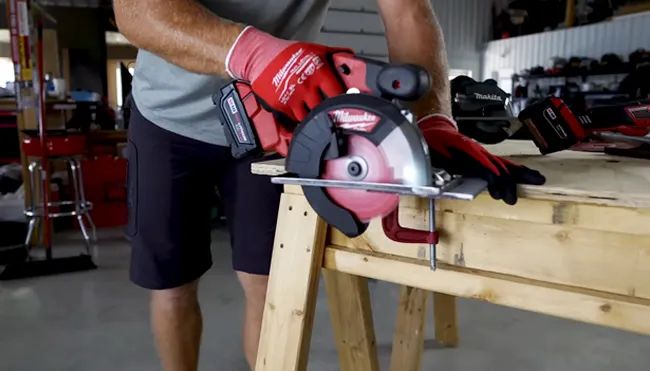
While wood cutting blades are capable of slicing through non-ferrous metals like aluminum and bronze, they aren’t suitable for cutting harder metals.
As far as I know, wood circular saw blades are designed specifically for woodworking applications and unsuitable for cutting steel or iron. The teeth on wood cutting blades are typically larger and less durable than blades specifically designed for cutting metal.
Attempting to cut harder metals with a wood circular saw blade can result in damage to the blade, the saw, and even potential injury to the operator. So, I advise using the appropriate blade for the specific material being cut to ensure clean, precise, and safe cuts.
Can you cut galvanized steel with a circular saw?
You can cut galvanized steel with a circular saw fitted with the appropriate blade. I believe to ensure a clean and efficient cut, it’s recommended to use a 7 ¼ inch fiber blade.
Galvanized steel, which is steel coated with a layer of zinc to protect against corrosion, can be cut using this method. However, it’s important to note that the zinc coating may cause the blade to wear down more quickly than cutting other metal types.
After cutting, it may be necessary to smooth rough edges using a steel reamer. This will help achieve a clean and professional finish.
What materials can not be cut using a circular saw?
According to my findings, three materials can’t be cut using a circular saw.
- The first is hard non-ferrous metals, such as uranium and plutonium. These metals are too hard for the saw’s teeth to cut through effectively and tend to stick to the teeth. This makes it difficult to achieve a clean and precise cut.
- The second material is the ABC group of metals, which are soft and prone to sticking to the face of the saw teeth. This can lead to a buildup of material on the teeth, affecting the saw’s cutting performance.
- Lastly, it’s important to note that circular saws should not be used on any materials that the manufacturer doesn’t recommend. Doing so can damage the saw or create potential safety hazards.
Circular Saw Metal Cutting: Specialized Blades for Precision and Efficiency
In my opinion, cutting metal with circular saws requires careful consideration of factors such as blade type, speed, and lubrication. While wood circular saw blades can cut through thin metal, they aren’t recommended for heavy-duty metal cutting.
However, specialized metal cutting blades are available for circular saws, offering precise and efficient cutting of various metals, including galvanized steel.
The detailed steps I outlined above serve as a guide for commercial or occasional use of circular saws for metal cutting. By focusing on the intricacies of the cutting process, users can confidently navigate the challenges of metal cutting.

